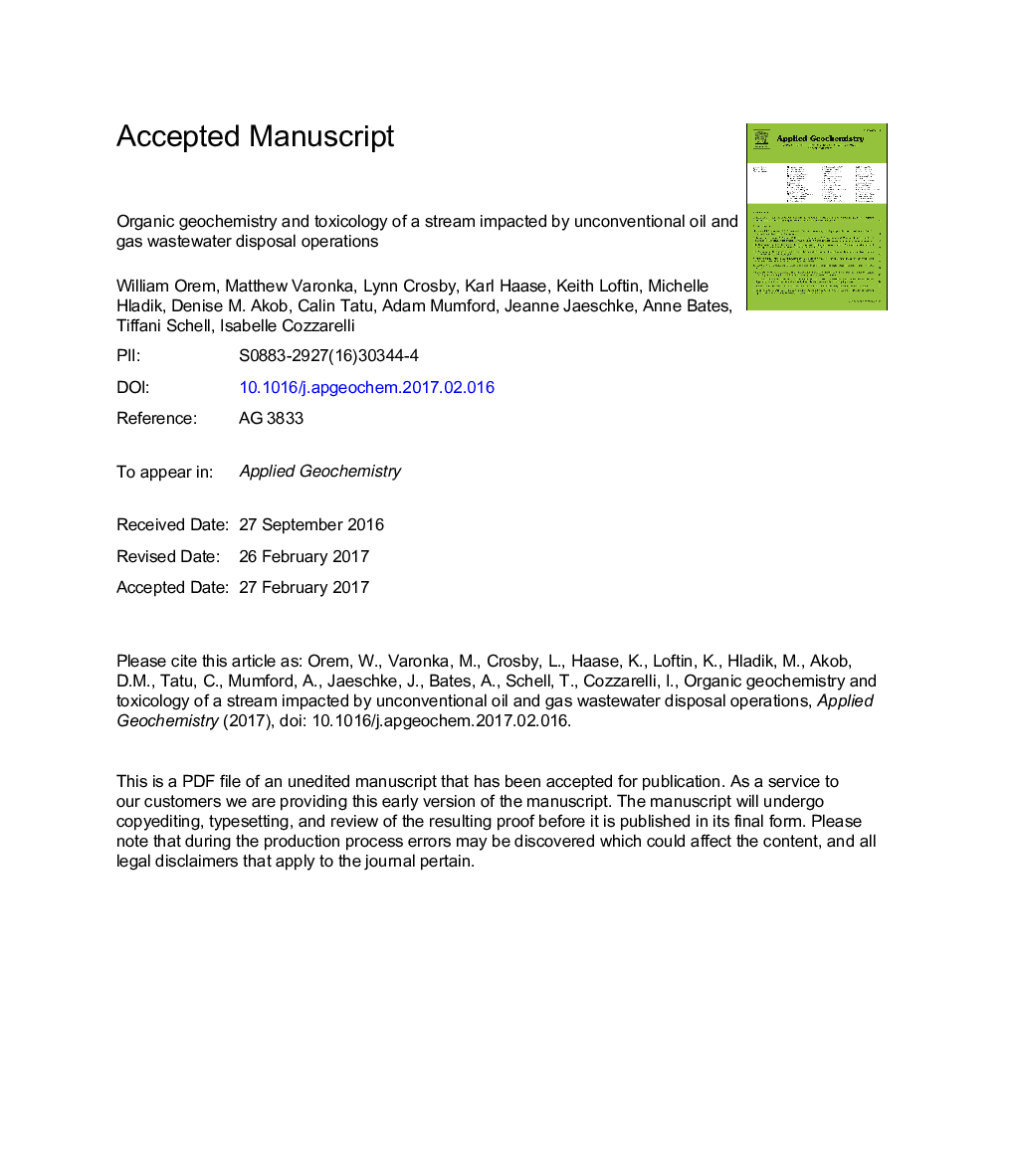| کد مقاله | کد نشریه | سال انتشار | مقاله انگلیسی | نسخه تمام متن |
|---|---|---|---|---|
| 5752589 | 1620211 | 2017 | 40 صفحه PDF | دانلود رایگان |
عنوان انگلیسی مقاله ISI
Organic geochemistry and toxicology of a stream impacted by unconventional oil and gas wastewater disposal operations
ترجمه فارسی عنوان
زمین شناسی ارگانیک و سم شناسی جریان از طریق عملیات دفع فاضلاب غیرمعمول نفت و گاز
دانلود مقاله + سفارش ترجمه
دانلود مقاله ISI انگلیسی
رایگان برای ایرانیان
کلمات کلیدی
موضوعات مرتبط
مهندسی و علوم پایه
علوم زمین و سیارات
ژئوشیمی و پترولوژی
چکیده انگلیسی
The large volume of wastewater produced during unconventional oil and gas (UOG) extraction is a significant challenge for the energy industry and of environmental concern, as the risks due to leaks, spills, and migration of these fluids into natural waters are unknown. UOG wastewater is often hypersaline, and contains myriad organic and inorganic substances added for production purposes and derived from the source rock or formation water. In this study, we examined the organic composition and toxicology of water and sediments in a stream adjacent to an underground injection disposal facility that handles UOG wastewaters. We sampled water and streambed sediments from an unnamed tributary of Wolf Creek upstream from the disposal facility, near the injection well, and downstream. Two sites downstream from the disposal facility contained organic compounds in both water and sediments that were consistent with a source from UOG wastewater. These compounds included: 2-(2-butoxyethoxy)-ethanol, tris(1-chloro-2-propyl)phosphate, α, α-dimethyl-benzenemethanol, 3-ethyl-4-methyl-1H-pyrrole-2,5-dione, and tetrahydro-thiophene-1,1-dioxide in water, diesel fuel hydrocarbons (e.g. pentacosane, Z-14-nonacosane), and halogenated hydrocarbons (e.g., 1-iodo-octadecane, octatriacontyl trifluoroacetate, dotriacontyl pentafluoropropionate) in sediments. Concentrations of UOG-derived organic compounds at these sites were generally low, typically 4 to <1 μg/L in the water, and <70 μg/g (dry wt.) in the sediment. In addition, water and sediment at a site immediately downstream from the facility contained many chromatographically unresolved and unidentified hydrocarbons. In contrast, sites upstream from the facility or in nearby watersheds not influenced by the disposal well facility contained primarily natural (biologically produced) organic substances from the local environment. Toxicological assays of human cell line exposures to water and sediment showed minimal effects. Results indicate that UOG wastewater has entered the stream and that UOG-derived organic substances are present. The contamination level, however, is low and appears to be restricted to sites immediately downstream from the disposal facility at this time.
ناشر
Database: Elsevier - ScienceDirect (ساینس دایرکت)
Journal: Applied Geochemistry - Volume 80, May 2017, Pages 155-167
Journal: Applied Geochemistry - Volume 80, May 2017, Pages 155-167
نویسندگان
William Orem, Matthew Varonka, Lynn Crosby, Karl Haase, Keith Loftin, Michelle Hladik, Denise M. Akob, Calin Tatu, Adam Mumford, Jeanne Jaeschke, Anne Bates, Tiffani Schell, Isabelle Cozzarelli,
